[English] 日本語
 Yorodumi
Yorodumi- PDB-8tok: nhTMEM16 lipid scramblase in lipid nanodiscs with MSP2N2 scaffold... -
+ Open data
Open data
- Basic information
Basic information
| Entry | Database: PDB / ID: 8tok | ||||||
|---|---|---|---|---|---|---|---|
| Title | nhTMEM16 lipid scramblase in lipid nanodiscs with MSP2N2 scaffold protein in the presence of Ca2+ (open state) | ||||||
 Components Components | Lipid scramblase nhTMEM16 | ||||||
 Keywords Keywords | LIPID TRANSPORT / membrane protein / lipid scramblase / TMEM16 | ||||||
| Function / homology |  Function and homology information Function and homology informationcortical endoplasmic reticulum / chloride channel activity / identical protein binding / metal ion binding / plasma membrane Similarity search - Function | ||||||
| Biological species |  Fusarium vanettenii 77-13-4 (fungus) Fusarium vanettenii 77-13-4 (fungus) | ||||||
| Method | ELECTRON MICROSCOPY / single particle reconstruction / cryo EM / Resolution: 3.84 Å | ||||||
 Authors Authors | Feng, Z. / Accardi, A. | ||||||
| Funding support |  United States, 1items United States, 1items
| ||||||
 Citation Citation |  Journal: Nat Struct Mol Biol / Year: 2024 Journal: Nat Struct Mol Biol / Year: 2024Title: Structural basis of closed groove scrambling by a TMEM16 protein. Authors: Zhang Feng / Omar E Alvarenga / Alessio Accardi /  Abstract: Activation of Ca-dependent TMEM16 scramblases induces phosphatidylserine externalization, a key step in multiple signaling processes. Current models suggest that the TMEM16s scramble lipids by ...Activation of Ca-dependent TMEM16 scramblases induces phosphatidylserine externalization, a key step in multiple signaling processes. Current models suggest that the TMEM16s scramble lipids by deforming the membrane near a hydrophilic groove and that Ca dependence arises from the different association of lipids with an open or closed groove. However, the molecular rearrangements underlying groove opening and how lipids reorganize outside the closed groove remain unknown. Here we directly visualize how lipids associate at the closed groove of Ca-bound fungal nhTMEM16 in nanodiscs using cryo-EM. Functional experiments pinpoint lipid-protein interaction sites critical for closed groove scrambling. Structural and functional analyses suggest groove opening entails the sequential appearance of two π-helical turns in the groove-lining TM6 helix and identify critical rearrangements. Finally, we show that the choice of scaffold protein and lipids affects the conformations of nhTMEM16 and their distribution, highlighting a key role of these factors in cryo-EM structure determination. | ||||||
| History |
|
- Structure visualization
Structure visualization
| Structure viewer | Molecule:  Molmil Molmil Jmol/JSmol Jmol/JSmol |
|---|
- Downloads & links
Downloads & links
- Download
Download
| PDBx/mmCIF format |  8tok.cif.gz 8tok.cif.gz | 227.3 KB | Display |  PDBx/mmCIF format PDBx/mmCIF format |
|---|---|---|---|---|
| PDB format |  pdb8tok.ent.gz pdb8tok.ent.gz | 180.6 KB | Display |  PDB format PDB format |
| PDBx/mmJSON format |  8tok.json.gz 8tok.json.gz | Tree view |  PDBx/mmJSON format PDBx/mmJSON format | |
| Others |  Other downloads Other downloads |
-Validation report
| Summary document |  8tok_validation.pdf.gz 8tok_validation.pdf.gz | 1.1 MB | Display |  wwPDB validaton report wwPDB validaton report |
|---|---|---|---|---|
| Full document |  8tok_full_validation.pdf.gz 8tok_full_validation.pdf.gz | 1.1 MB | Display | |
| Data in XML |  8tok_validation.xml.gz 8tok_validation.xml.gz | 47.5 KB | Display | |
| Data in CIF |  8tok_validation.cif.gz 8tok_validation.cif.gz | 70.7 KB | Display | |
| Arichive directory |  https://data.pdbj.org/pub/pdb/validation_reports/to/8tok https://data.pdbj.org/pub/pdb/validation_reports/to/8tok ftp://data.pdbj.org/pub/pdb/validation_reports/to/8tok ftp://data.pdbj.org/pub/pdb/validation_reports/to/8tok | HTTPS FTP |
-Related structure data
| Related structure data |  41454MC 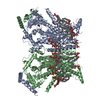 8toiC 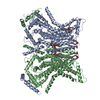 8tolC  8tpmC 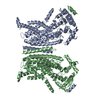 8tpnC  8tpoC 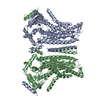 8tppC  8tpqC 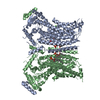 8tprC  8tpsC 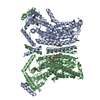 8tptC M: map data used to model this data C: citing same article ( |
|---|---|
| Similar structure data | Similarity search - Function & homology  F&H Search F&H Search |
- Links
Links
- Assembly
Assembly
| Deposited unit | 
|
|---|---|
| 1 |
|
- Components
Components
| #1: Protein | Mass: 83294.062 Da / Num. of mol.: 2 Source method: isolated from a genetically manipulated source Source: (gene. exp.)  Fusarium vanettenii 77-13-4 (fungus) / Gene: NECHADRAFT_66456 / Production host: Fusarium vanettenii 77-13-4 (fungus) / Gene: NECHADRAFT_66456 / Production host:  #2: Chemical | ChemComp-CA / Has ligand of interest | Y | |
|---|
-Experimental details
-Experiment
| Experiment | Method: ELECTRON MICROSCOPY |
|---|---|
| EM experiment | Aggregation state: PARTICLE / 3D reconstruction method: single particle reconstruction |
- Sample preparation
Sample preparation
| Component | Name: Dimeric lipid scramblase nhTMEM16 / Type: COMPLEX / Entity ID: #1 / Source: RECOMBINANT | ||||||||||||||||||||
|---|---|---|---|---|---|---|---|---|---|---|---|---|---|---|---|---|---|---|---|---|---|
| Source (natural) | Organism:  Fusarium vanettenii 77-13-4 (fungus) Fusarium vanettenii 77-13-4 (fungus) | ||||||||||||||||||||
| Source (recombinant) | Organism:  | ||||||||||||||||||||
| Buffer solution | pH: 8 | ||||||||||||||||||||
| Buffer component |
| ||||||||||||||||||||
| Specimen | Conc.: 5 mg/ml / Embedding applied: NO / Shadowing applied: NO / Staining applied: NO / Vitrification applied: YES / Details: This sample was monodisperse | ||||||||||||||||||||
| Vitrification | Instrument: FEI VITROBOT MARK IV / Cryogen name: ETHANE / Humidity: 100 % / Chamber temperature: 288 K |
- Electron microscopy imaging
Electron microscopy imaging
| Microscopy | Model: TFS GLACIOS |
|---|---|
| Electron gun | Electron source:  FIELD EMISSION GUN / Accelerating voltage: 200 kV / Illumination mode: OTHER FIELD EMISSION GUN / Accelerating voltage: 200 kV / Illumination mode: OTHER |
| Electron lens | Mode: OTHER / Nominal defocus max: 2000 nm / Nominal defocus min: 1000 nm |
| Image recording | Average exposure time: 3.4 sec. / Electron dose: 30 e/Å2 / Film or detector model: FEI FALCON IV (4k x 4k) / Num. of real images: 9493 |
| EM imaging optics | Energyfilter slit width: 20 eV |
- Processing
Processing
| EM software |
| ||||||||||||||||||||||||||||||||||||||||
|---|---|---|---|---|---|---|---|---|---|---|---|---|---|---|---|---|---|---|---|---|---|---|---|---|---|---|---|---|---|---|---|---|---|---|---|---|---|---|---|---|---|
| CTF correction | Type: PHASE FLIPPING AND AMPLITUDE CORRECTION | ||||||||||||||||||||||||||||||||||||||||
| Particle selection | Num. of particles selected: 1948732 | ||||||||||||||||||||||||||||||||||||||||
| 3D reconstruction | Resolution: 3.84 Å / Resolution method: FSC 0.143 CUT-OFF / Num. of particles: 250756 / Symmetry type: POINT | ||||||||||||||||||||||||||||||||||||||||
| Atomic model building | PDB-ID: 6QMA Accession code: 6QMA / Source name: PDB / Type: experimental model |
 Movie
Movie Controller
Controller














 PDBj
PDBj


